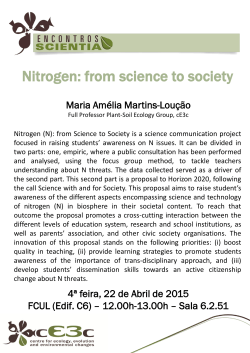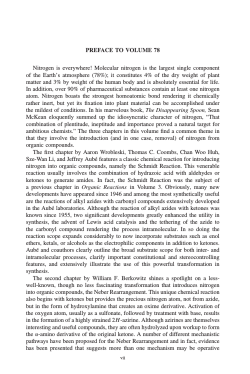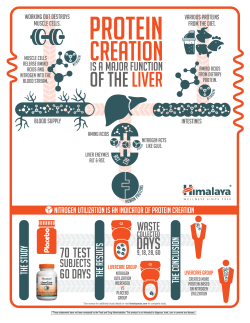
Preface - Wiley Online Library
PREFACE TO VOLUME 85 The Preface to Volume 78 highlighted the importance of nitrogen and nitrogencontaining compounds. Not only are organonitrogen compounds essential for life, they are absolutely ubiquitous in natural and non-natural substances, ranging from Round-Up,™ Kevlar,™ and explosives to penicillin, Viagra,™ and strychnine! In his wonderful collection of Chemical Poems: One for Each Element, Mario Markus juxtaposes the dichotomy of importance, ubiquity, and contrasting uses of nitrogen with these two stanzas, “The engine of life is around us and it is dead. A corpse that gives life, a corpse that kills.” The three chapters in Volume 78 describe chemical transformations that either introduce nitrogen through the agency of fascinating rearrangement reactions (Schmidt Reaction and Neber Reaction) or the removal of nitrogen for the purposes of uniting separate carbon atoms (extrusion reactions). Obviously, the ability to selectively and efficiently introduce nitrogen functions into organic compounds is of paramount importance to the entire chemical enterprise. For aliphatic compounds, the ability to introduce nitrogen functions by harnessing the nucleophilic character of amines, azides, nitrites, et al. in simple displacement reactions has been of fundamental importance for decades. However, the analogous introduction of nitrogen functions by displacement with aromatic or unsaturated compounds is significantly more limited and required the use of stoichiometric amounts of copper in high-boiling solvents in the well-known Ullmann and Goldberg reactions. In the 1990’s, the advent of palladium-catalyzed amination of aryl and especially heteroaryl halides with various nitrogen-based nucleophiles (Hartwig-Buchwald reaction) revolutionized the synthesis of aromatic amines. Although the impact of this method cannot be overstated, the cost of palladium precatalysts and highly engineered phosphorus-based ligands provided incentives to revisit the use of “earth-abundant” copper and simpler ligand systems. The success of these research efforts forms the basis for the single chapter in this volume, namely, Copper-Catalyzed Amination of Aryl and Alkenyl Electrophiles by Kevin H. Shaughnessy, Engelbert Ciganek, and Rebecca B. DeVasher. The Board of Editors was hesitant to commission a chapter of this magnitude, but the importance of the chemistry motivated the search for authors with expertise and commitment to undertake such a massive effort. Our hopes could not have been better rewarded. The original authors, Drs. Shaughnessy and DeVasher, have compiled an enormous (and growing) literature and distilled it into an extraordinarily useful treatise on all aspects of the copper-catalyzed amination process. Given the myriad types of nitrogen-based nucleophiles and various ligand sets and reaction conditions, the authors have done an outstanding job of identifying the best options for various permutations of donor and acceptor. This comprehensive treatment of so many different options constitutes a dream “field guide” for the perplexed chemist who wants to know how best to vii viii PREFACE TO VOLUME 85 approach the formation of a C-N bond in a target structure and whether copper or palladium catalysis is recommended. Still more astonishing to the Board of Editors was the speed with which the chapter materialized. The period from invitation to delivery of the complete chapter was less than three years, an extraordinary feat for a project of this magnitude. However, in its original form, the sheer size of the tabular survey exceeded the limits of a single volume and thus threatened our ability to produce this definitive work in a manageable format. It is our great fortune that long-time Organic Reactions board member (and multiple chapter author), Dr. Engelbert Ciganek, volunteered to condense the tabular survey into sub-tables that would significantly reduce its size and thus allow publication in its current form. However, what Dr. Ciganek accomplished is much more than a condensation of size. The juxtaposition of all of those related examples together with conditions and results is incredibly valuable to the practitioner. No such curated presentation of distilled data can be obtained from a SciFinder or Reaxys search. It is this critical analysis of the field (in the text) and such comparative analysis of the known examples in a comprehensive format that is the hallmark of Organic Reactions chapters. In recognition of his tremendous efforts, Drs. Shaughnessy and DeVasher graciously allowed Dr. Ciganek to be a coauthor of this chapter. Volume 85 represents the ninth single chapter volume to be produced in our 72-year history. Such single-chapter volumes represent definitive treatises on extremely important chemical transformations. The organic chemistry community owes an enormous debt of gratitude to the authors of such chapters for the generous contribution of their time, effort, and insights on reactions that we clearly value. It is appropriate here to acknowledge the expert assistance of the entire editorial board, and in particular John Montgomery, who shepherded this massive chapter to completion. The contributions of the authors, editors, and the publisher were expertly coordinated by the responsible secretary, Dr. Robert Bittman. In addition, the Organic Reactions enterprise could not maintain the quality of production without the dedicated efforts of its editorial staff, Dr. Linda S. Press, Dr. Danielle Soenen, and Dr. Dena Lindsay. Insofar as the essence of Organic Reactions chapters resides in the massive tables of examples, the authors’ and editorial coordinators’ painstaking efforts are highly prized. Scott E. Denmark Urbana, Illinois
© Copyright 2025









